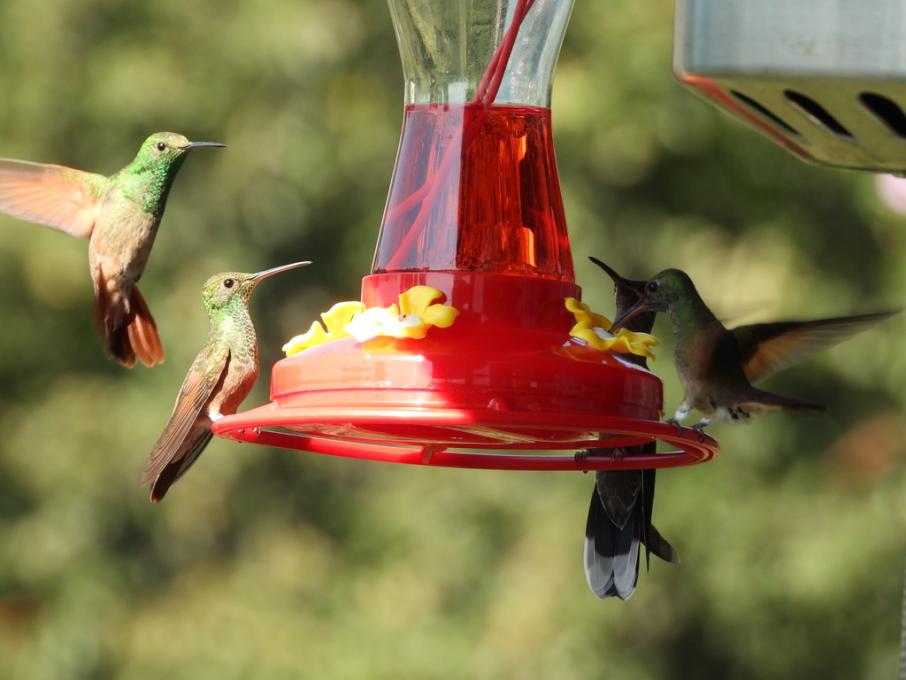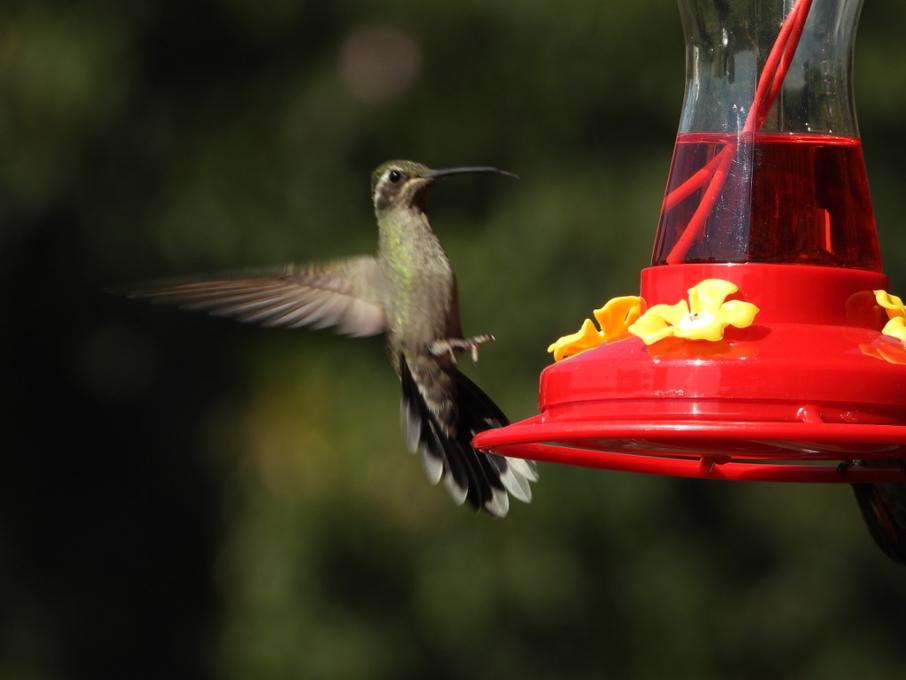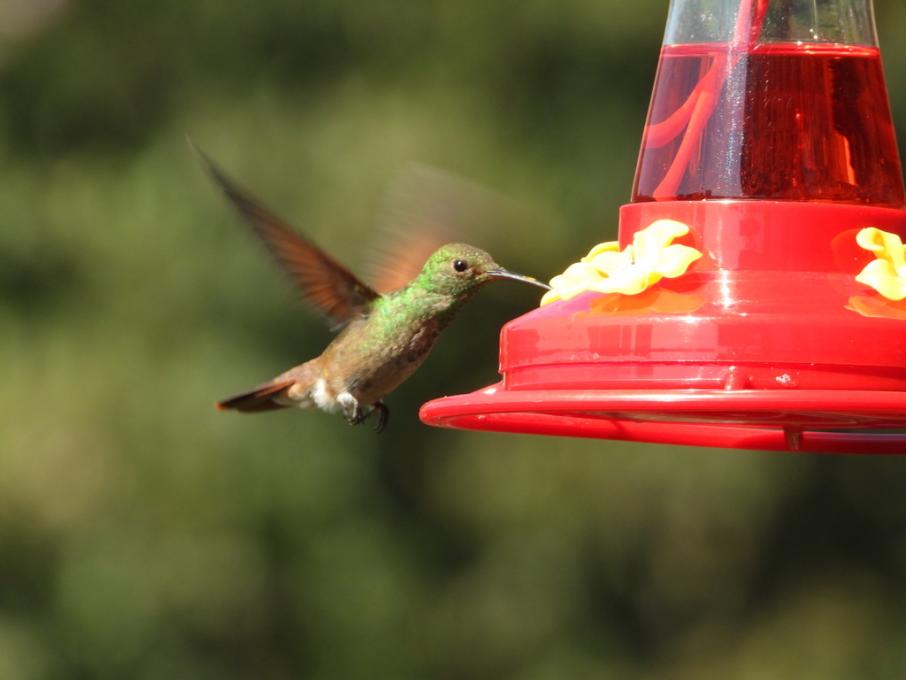The Cornell Lab Bird Academy › Discussion Groups › The Wonderful World of Hummingbirds › What Makes a Hummingbird a Hummingbird
-
What is the reason that Jacobins and Topazes are considered 1 group of hummingbirds and are not in separate groups?
-
I live in Mexico City and have been observing our hummingbirds at the feeders that we put out. From what I can see, we have 2 types. One that I had heard is called Berylline, that is the smaller more copper colored one and the other I thought was called a Stripe-Eared but after this first part of the hummingbird course it looks like it is a Mountain-gem..can anyone help me to identify them for sure?



-
We Are in Ontario, so I suppose I know our Hummingbird, since there is only one. I wonder, is that because it is territorial and drove out the other kinds? Or because humans’ industrialization (and pollution) made it uninhabitable for the other varieties? Is it the hazards of the trip during migration? Hummingbirds seem to live in all climate types, and in coastal and mountain regions. We have plenty of forests in post industrial New England and northern Ontario…certainly there seems to be a lot of nectar around.
-
The Olympic peninsula has Annas year round and Rufous in the summertime. The last two winters were really cold and were really hard on our hummers.
-
Calliope and Rufous in MT. Anna's, Costa's, Black-chinned in CA. Ruby-throated and a vagrant Broad-billed in NC. Giant in Peru. Rufous-tailed in Costa Rica. Several of these are featured in this course.
-
Ruby-throated hummingbirds in FL
Calliope hummingbird in UT
Black-chinned hummingbird- UT
Rufous hummingbird-CO
Broad-tailed hummingbird-UT
Looking forward to seeing many more. -
I have seen almost 30 species of Hummingbirds. Most of them (11 species) have been from several trips to Colombia. I am originally from Puerto Rico where I was raised looking at some endemic hummingbirds. Living in the USA I have seen 8 species. In total I have seen 11 species of the ones featured in the course.
-
I have ruby throated in my backyard near Boston, MA. They can be fierce! What sparked my interest though was as a schoolgirl visiting the natural history museum in Tring, England. They had about 200 or 300 specimens, plus some nests and eggs. Obviously these were not live, which is what you asked about, but I’ve never forgotten the marvel.
-
Yes! Ruby throated hummingbird in Houston! I was over the moon. Come to zinnias in my butterfly garden - but didn’t stay.
-
I live in Colorado and I’ve seen the Rufous and Broad-tailed Hummingbirds, particularly when I go hiking. I am thinking about putting up a hummingbird feeder; however, haven’t so far. Enjoying the course so far.
-
The reason I'm taking this course is because I have Ruby Throated Hummingbirds every year and I want to know more about how they can possibly migrate so far, are they same ones every year, and also what predators exist. So far, the range and diversity we're learning about in the rest of the world (I live in the Northeast) is fascinating!
-
Ruby throated hummingbirds only, as I live in NJ. I choose not to but out a feeder and instead plant flowers and bushes in which hummers and butterflies love.
-
I live in NE PA and have been watching and feeding Ruby-throated Hummingbirds for years. It's so exciting when they first show up!
-
We are staying in Rhinebeck, NY this July and I am seeing Ruby-throated hummingbirds on the Scarlet bee balm flowers sipping nectar. They are so fun to watch and after learning about iridescence (had to look up the spelling!) we looked at it from a different perspective! We are in Florida most of the year and I have the prepared syrup in my fridge and am afraid to use it to feed the hummingbirds. Someone told me you have to be careful in Florida with the heat and bacteria etc. Is it okay to have a hummingbird feeder in SW FL?
-
I've come to learn that you cannot use anything other than white granulated sugar to make their nectar...one part sugar to 4 part water. The sugar solution in the feeder must be changed out every few days, for 2 reasons. One is that the sugar water will ferment causing an alcohol to be formed which will kill them, the other reason is that black mold can develop and contaminate the water. Check it out on the International Hummingbird Society....https://www.hummingbirdsociety.org/feeding-hummingbirds
-
-
There are nine groups of hummingbirds based on genetic similarities. I have looked all over the Cornell website for the definition of 'group' but cannot find anything.
I'm not the best researcher and fault my research skills. Can someone tell me what the definition of group is and where can I find it? Thanks-
Do I understand your question correctly? I think you mean: Kingdom, order, family, genus, species, but what is group? I am a fellow student, but I think it means 9 groups of similar birds within the species Colubris.
KINGDOM
Animalia
ORDER
Apodiformes (swifts & hummingbirds)
FAMILY
Trochilidae (hummingbirds)
GENUS
Archilochus
SPECIES (specific epithet)
colubris -
I think that "group" is loosely defined here; I assume you are referring to the 9 groups listed early on in this section (Bees, Emeralds, etc.). I do not think that there is an official definition of "group". It seems that the 9 groups are based on genetic similarities. The video clip list some characteristics of these groups, though does not provide any strict definitions (e.g., what makes a "bee" a "bee" and how does it differ from an "emerald"). That may be hard to do at this point, since the groupings are based on genetic similarities rather than strict similarities in how they look.
Ideally these groups would coincide with specific GENUS names. It seems that this might be the case for the small groups (Jacobyn, Topaz, and Giant Hummingbird groups), but there are way more hummingbird genera (plural of "genus") than the listed "groups" (106 versus 9). So the groups appear to be just a convenient way to organize the large number of species.
-
-
I have been putting out nectar feeders for out ruby-throated hummingbirds here in southeastern Pennsylvania for a number of years. The funniest thing I ever saw was a juvenile wren who landed on the support for the nectar feeder and looked in absolute wonder at the hovering hummingbird feeding!
-
I believe an Anna's Hummingbird spent most of the winter at my feeder here in Seattle WA- Went through a lot of sugar to keep the feeder full. Now that the flowers are in bloom I have only seen it a few times. I didn't know how territorial they were till other hummingbirds came to the feeder and were "sent " away by the resident hummingbird.
-
I will never forget the first time I saw a hummingbird. I was in my 40s and visiting family in the suburbs of Philadelphia. Suddenly, what I thought was a large insect went lightning fast zig-zagging across their property. I was overcome with joy as I realized that’s not an insect, that’s a hummingbird! THAT’S A HUMMINGBIRD!
-
Yes. We have a lot of ruby throated hummingbirds in Maine and we put up feeders and actually see what we call the hummingbird wars. They often come close to me and my husband if we have on a colorful article of clothing. We also have what we thought were migrators in Florida but this year I left my feeders up until they stopped coming and they didn't until spring. Is that ok or should we encourage them to go farther south?
My husband also plants a lot of hummingbird friendly flowers and when we see them liking a particular kind, he plants more of those. -
Ruby throated hummingbird and Rufous hummingbird
-
I live in MA, and have seen the ruby throated hummingbirds occasionally over the years. A local friend and his wife have red flowering plants on their deck, with hummingbirds being so common there, they can feel like very large bees buzzing during early summer evening get togethers.
This year, I put out a feeder for the first time, and it has been enjoyable watching them, more enjoyable than almost any other birds. From limited observations and no birding cam;
Females have been at the feeder 90% of the time
Females have been more aggressive in bumping others away from the feeder
Females have perched while feeding more than males, who are more likely to feed while hovering
They have sometimes hung out perching for a while, rubbing their bills on the feeding structure, shaking their tail feathers, looking around, and often going back for more.
It was surprising that they appeared so relaxed to perch for an extended time, and I was sure if that was because there are hydrangea bushes close by with very similar green coloring, or if they are so fast and quick that they aren't concerned with others. It would be great to get any feedback on this.
This first section of the course has been illuminating and exciting. Looking forward to the rest of it, and opportunities to see more species in the future. -
The hummingbird that stands out to me that I have seen this year is blackhead with maroon gorget and white belly. It is so pretty. I have not; that I know of seen it featured in these lessons but I am in the Eastern side of the US. Only been able to view the three different ones for about two weeks with this being July. the other two; one is mostly green and the other is a mostly light grey. These last two come and go quickly but the white and black will hover longer giving me a better look. Last year was the first year I put out the nectar (homemade) so I am hoping to get more species and colors each year. For those that have been doing this for years I have a question. Last year my feeder was in my back yard and I put it back there again this year. I bought another feeder and have put it near a window in my front yard. It has only been a day but so far they have not seemed to have found it. Question is do you think they will find it or should I just put it in their paths near the one on the back side? Thnx for any feedback. I'm sure the white black red is a ruby throated hummingbird just I don't believe I seen it in the lesson as that color.
Mary-
HI, my experience is that the hummingbirds will find the location of your new feeder although it may take a few days for them to check it out. Give them time and have fun seeing all they do!
-
I put my first feeder on our front porch, where I can see them at dinner. I get loads of teasing for “staring” just over my nephew’s left shoulder at dinner! We put another out back and the came to that one too. Any luck yet with your second feeder?
-
-
Yes! I see two hummingbird species on a regular basis when I go on short walks or long hikes in my area. These species are the Anna's Hummingbird and the Rufous Hummingbird, which I learned in this lesson are considered to be in the hummingbird genetic group called Bee.
-
I live in Central Illinois and Ruby-Throated Hummingbirds are common here. I plant flowers on my front deck that attract them every year and also keep hummingbird feeders out. They are endlessly entertaining to watch!
-
I haven't got the chance to experience the Ruby-Throated Hummingbird yet, but I look forward to seeing them in the future! I agree that hummingbirds are entertaining to watch.
-
Read More:


